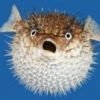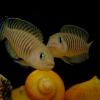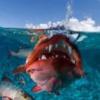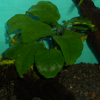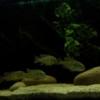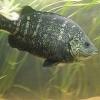Over the last year or two I have kept mainly Australian Native Fish. There are only around 280 species of freshwater fish native to the whole of Australia. To put that in some perspective, there are about 1,000 species of cichlids native to Lake Malawi alone.
Though there are only relatively few species of freshwater fish native to Australia they are remarkably diverse and amazing to keep. Whilst some of the species I have kept are quite well documented in aquariums, most aren't.
I decided to write this "article" as a starting point for aquarists looking for information on native oddballs and large predators. The information is by no means comprehensive on any one species. Hopefully though it gives potentially interested aquarists a heads up on whats out there and what they are like to own.
So, I have been regularly editing this post and thought it would be worthwhile mentioning the best places in WA to obtain native fish:
- Pet Magic Bibra Lake and Cannington: http://www.petmagic.com.au/
- Livefish.com.au
Best bet is to keep an eye on Bayfish and Aquarium Industries stock lists and call your LFS for a special order if you see something you want.
Of particular help in this matter have been the following:
- Pet City Butler (9562 0995) who deal with Bayfish and;
- Pet Professionals Wanneroo (9405 7117) who deal with Aquarium Industries.
Murray Cod Macchullochella peelii peelii
Temperature: 18 - 24 can tolerate temps as low as 8.
pH Level: 7 - 8
General Hardness: Moderate
Max. Size: 1.8 meters (113kg)
Realistic Max. Size: 1 meter + (10 15kg)
Tank Size: 6x2x2 bigger as required.
Feeding: Large high protein pellets, frozen or fresh fish/prawns, Live feeders
Temperament: Brutally Aggressive
About: The Murray Cod has to be my favourite fish of all time. Big, aggressive and full of personality. To start off with though, they are unbelievably small for a fish with so much genetic potential. Murray Cod are available from hatcheries for around $2.50 each @ 3cm in Queensland and northern NSW from December through to February and sometimes well into autumn (Cod spawning in captivity is improving rapidly). To legally import them into WA you will require a translocation permit from Fisheries. .. Good luck with that. LFS sometimes have cod in stock from Jan - March, usually they sell for about $20.
Murray Cod will eat just about anything as they get older but really should be fed primarily quality dry food. Younger fingerlings do very well on mosquito larvae and blackworms until they are big enough to be weaned onto pellets.
I have found Murray Cod to be quite hardy with no special water chemistry requirements; in fact Perths water supplies seem to suit them and most other natives quite well (Once water conditioner has been added of course). I have read that they can be subject to recurring fungal outbreaks, though this is probably as a result of some other untreated condition compromising the fish's immune system or tank equilibrium. Murray Cod are commonly kept with the odd handful of aquarium salt added to prevent any fungal outbreaks. There are many sources of information out there that recommend cod be kept at 1ppt aquarium salt. I have done this with very small cod but I don't bother with it once they are growing and looking healthy.
Cod should be kept alone; they will try and eat everything else
They arent really regarded as jumpers but I once walked into my garage to find my (at the time) 30cm cod on the floor beside his tank He came good but the lesson was quickly learned and lids were sourced for ALL my tanks.
Cod are usually shy for the first 6 - 12 months or so before rapidly growing in confidence and becoming VERY interactive with their masters. They will grow quickly in their first two years so be prepared to dedicate a large tank to your cod from the start or to upgrade very, very soon.
Mangrove Jack Lutjanus argentimaculatus
Temperature: 22 - 27
pH Level: 7.2 - 8.2
General Hardness: Medium - Hard
Max. Size: 120cm
Realistic Max. Size: 70cm
Tank Size: 6x2x2 +
Feeding: Large high protein pellets, frozen or fresh fish/prawns, Live feeders
Temperament: Brutally Aggressive
About: By far and away one of the most attractive Australian Native fish. These guys are super aggressive. With only the rarest of exceptions they must be kept alone. Shane_H managed to keep his with a barra and large sailfin pleco but generally Mangrove Jacks surprise even long time owners with their sheer aggression. Jack keepers nearly always offer the same advice; don't keep jacks with any fish that you wish to keep alive.
Jacks have an interesting life cycle in the wild In a nutshell; they spawn in marine environment. Young free swimmers head for fresh to brackish water to find a snag to take up semi-permanent residence. As they get older 40 50cm they head back into brackish and eventually into a full marine environment. It is supposed that Jacks living in subtropical regions such as Northern NSW may annually migrate between marine reefs and rivers and estuaries. In aquariums older Jacks seem to be kept in either pure fresh water or mostly freshwater with just a touch of salt.
I recommend not using API Algaefix or any similar product with a Jack. I have personal experience with this issue, nearly losing my Jack to a standard dose in a 4x1.5x1.5, as well as the anecdotal experience of another PCS member who lost his juvenile Jack ( http://www.perthcich...showtopic=59042 ).
Jacks have a slower growth rate than most of Australias big predators, especially in the first year.
Most specimens in the aquarium trade are wild caught. There is currently only one hatchery that spawns Mangrove Jacks in Australia (GAWB Gladstone Area Water Board). To my knowledge Jacks were not spawned by GAWB in 2014. Price for these fish depends largely on availability and size. In 2013 small Jacks were selling for around $60 in 2015 the cheapest I saw them selling for was at Aquotix and on Livefish for $120. 2016/17 small jacks have been selling for around $160 - $200. Some were available cheaper over east of course. Jacks @ 40cm can sell for around $500.
Barramundi Lates calcarifer
Temperature: 22 - 29
pH Level: 7.0 - 8.0
General Hardness: Moderate
Max. Size: 180cm
Realistic Max. Size: 1m
Tank Size: 6x2x2 +
Feeding: Large high protein pellets, frozen or fresh fish/prawns, Live feeders
Temperament: Highly predatory but not normally aggressive toward fish it cant eat.
About: Barra are generally peaceful in aquariums with fish of a similar size, though there are of course exceptions to the rule with reports of particularly agro barra attacking pretty much any tank mate. Usually though they do not do well with aggressive tank mates. Keeping Barra of differing sizes will generally lead to cannibalism not unlike most Aussie preds.
They are very aggressive feeders making them something of a nuisance when kept with less active feeders like sleepy cod. Barra have an unbelievable appetite and grow very fast in their first two years. Barra fingerlings are available for just a couple of dollars each for 5cm fingerlings from hatcheries. LFS usually sell them for about $10 each at the same size. It is usually easy to find barra 20 - 30cm on Gumtree for $10 - $20 if you are after a fish with some size to it.
I have found them to be quite hardy as is their reputation. They leave plants well alone making it possible to create a quality display out of a barra tank. A word of warning though; they produce a lot of waste that must be removed from the tank regularly. With a bare bottom tank this is much easier (Same for all TBs).
Barra usually get along very well with bigger archers, scats, monos and sleepy cod.
Saratoga Leichardti Scleropages leichardti & Saratoga Jardini Scleropages jardini
Temperature: 18 - 27
pH Level: 6.8 - 8.0
General Hardness: Moderate
Max. Size: 100cm
Realistic Max. Size: 70cm
Tank Size: 6x2x2+
Feeding: Large high protein pellets/sticks, frozen or fresh fish/prawns, Live feeders
Temperament: Variable, can be and usually is very aggressive
About: Australias Arowana. They are beautiful display fish but as is typical of Aussie Preds they need to be kept alone. They often get along perfectly well with tank mates then suddenly turn nasty, inflicting massive damage in a very short period of time, even to bigger fish. Though Leis are a better option than Jars for attempting to keep with tank mates.
Leis are much more slender than their Jardini cousins, Leis often get to the same length but reach only around ¼ the total weight of jars. Saratoga prefer to occupy the top half of the tank. These guys are known as jumpers so strong and heavy lids are essential.
Expect to pay +$150 for a 7 - 8cm juvie. They are only available as juvies during the summer months. Saratoga are pretty fragile under 8cm so this is generally the smallest you will find them available at LFS. Hatcheries generally wont sell Saratoga to the public as it is considered primarily an aquarium species and they seem to have deals with wholesalers not to sell direct to hobbyists.
Coal Grunter Hephaestus carbo
Temperature: 21 - 27
pH Level: 6.8 - 7.6
General Hardness: Moderate
Max. Size: 30cm
Realistic Max. Size: 30cm
Tank Size: 4x2x2+
Feeding: Can be difficult to wean on to pellet. Prefers frozen/live foods such as blackworms
Temperament: Variable - seems to be more tolerant of fish totally unlike themselves (Catfish, Archers, Scats, Bullrout, Butis butis, etc)
About: Probably Australia's most strikingly coloured freshwater predator. Coal Grunters are usually a patterned Black and Gold though there are some amazing variants such as Black and Red which are far less common. Coal Grunters can be difficult to persuade to take pellets and seem to prefer Blackworms and live shrimp above all else. They have quite small mouths and target mostly smaller prey. In the wild they work together to harass and kill bigger prey. These guys don't get particularly big but they are VERY solid and aggressive. My Coal Grunter beat up a much larger Barramundi and had to be separated. They are hyperactive (opposite to most Aussie Preds) and are very entertaining to watch. They swim non-stop so they require a lot of swimming space, they are also very interactive with their masters.
Coal Grunters are fairly difficult to find in Perth these days but are pretty easy to find over east and are reasonably cheap, expect to pick one up for around $20 - 30. Juvies were available from Livefish in mid 2016 for $10.
Sooty Grunter Hephaestus fuliginosus
Temperature: 18 - 27
pH Level: 6.8 - 7.8
General Hardness: Moderate
Max. Size: 50cm
Realistic Max. Size: 40cm
Tank Size: 4x2x2+
Feeding: Large high protein pellets, frozen or fresh fish/prawns, Live feeders.
Temperament: Very aggressive even toward larger fish.
About: There are a few species known by the common name Sooty Grunter, by far the most common and attractive Sooty kept in aquaria is Hephaestus fuliginosus. Sooty's were available in Perth for the first time in years in 2017... but are generally quite easy to find in the eastern states. They are very aggressive, active and entertaining predators that seem to enjoy interaction with their masters. A very nice looking fish, these guys are quite hardy, accept most foods and make great pets. You should be able to pick them up for $20 - $30.
Sootys are often overlooked as they require a tank of their own due to their aggression and tendency to harass tank mates to the grave. Shouldn't be surprised that's what predators are all about. They are in many ways similar to a mangrove jack though they are smaller, blackish and probably wont ever pose a threat to your fingers in the way that jacks can.
Keep these fish on their own!!!!!
Sleepy Cod Oxyeleotris lineolata
Temperature: 22 - 27
pH Level: 6.8 - 8.0
General Hardness: Soft - Moderate
Max. Size: 45cm
Realistic Max. Size: 35cm
Tank Size: 5x2x2
Feeding: High protein pellets and meaty foods.
Temperament: Predatory but ignores fish too big to eat Mostly.
About: Strangely Sleepy's are one of my favourite fish. They are hideously ugly, sedentary and give the impression that they are stuck in a perpetual state of grumpiness Sounds like me! They often spend hours at a time completely still sitting on substrate or anything else for that matter. They are known to sleep vertically with their noses pointed either straight up or down Very concerning when you first see it.
They are pretty good tank mates for bigger fish. They like to have their own space and in my experience only bully other fish if confined too closely with others.
They are hit and miss feeders, sometimes feeding aggressively sometimes barely eating for days Best not to worry about it, they will eat when hungry. They can be hard to feed when kept with hyperactive feeders like Scats and Barra. I feed mine on predator sticks, mulies and prawns. Mine wont touch usual aquarium pellets but will occasionally eat Skretting Nova pellets. They are widely considered difficult to feed but I think they just give that impression with their slow metabolism and irregular eating habits, as I said; they eat when hungry. Sleepys are sedentary ambush predators and don't use a whole lot of energy so don't eat as much as they look like they should. Since I have moved mine onto Hikari Carni Sticks, he seems to have become a little more active and aggressive; he also eats more regularly than on other feeds. I cannot recommend Hikari highly enough for Sleepy Cod,
I have found them to be reasonably hardy but seem somewhat sensitive to less than ideal water conditions when other fish seem perfectly happy so it pays not to get lazy with water changes. I reckon they are better kept in a tank with little or no substrate to help keep nitrates down and the water generally better for longer.
I was keeping mine with some salt (<1ppt) but gradually moved to fresh water. I have a tank half full of vallis to help keep water clean and to give the Sleepy somewhere to hide and wait in ambush mode. I find the more interesting their environment, the more interesting and naturally they behave. A really great fish to observe.
Young Sleepy's are pretty cheap, less than $20 for a 6 - 8cm fish. I've seen 2 adults advertised in WA over the last 12 months, both were going for $50.
Silver Perch Bidyanus bidyanus
Temperature: 22 - 27. Can tolerate temps as low as 10. Disease susceptibility increases below 15.
pH Level: 6.8 - 7.8
General Hardness: Moderate - Hard
Max. Size: 40cm
Realistic Max. Size: 35cm
Tank Size: 6x2x2
Feeding: Eats any prepared foods
Temperament: Can get aggressive with smaller fish, fine in groups of 6 or more
About: Silver Perch are an interesting species when kept in a school of 6 or more. Less than that and I have found they develop too much of a pecking order and the weaker ones get bullied. A decent number of them though get along well enough. I kept mine with a juvie Murray Cod Well, until the cod snapped one day and started picking the Perch off despite the Perch being a few cm bigger.
Silver Perch have very small scales that are unsurprisingly silver grey, it may sound quite drab but the effect is actually quite striking!
Silvers are hardy and you are unlikely to have health problems as long as you source healthy fish to start with. They tolerate a huge temperature range but do better between 18 - 24 degrees. Silvers are great to watch in a tank with yabbies or marron. They do seem quite easily startled so make sure there is no sharp tank decor for them to injure themselves on. I have never known silvers to jump out of a tank, when startled they usually head down for cover rather than for the surface.
Silver Perch are not fussy eaters. I have fed mine everything from floating cichlid pellets to skretting sinking It all gets hammered.
Silver Perch are cheap as chips, usually available for around $5.00 each at 6 - 8cm from places like Woodvale Fish and Lilly Farm or Swan Valley Fish and Lilly Farm. Cheaper still from the hatchery.
Barcoo Grunter Scortum barcoo
Temperature: 18 - 27
pH Level: 7.0 - 8.0
General Hardness: Moderate
Max. Size: 35cm
Realistic Max. Size: 35cm
Tank Size: 4x2x2
Feeding: Omnivore, eats almost anything
Temperament: Peaceful with fish of a similar size. Some individuals can be more aggressive.
About: Also known as Jade Perch. These fish are a significant aquaculture species in Australia. They are often used in Aquaponics setups in tropical and sub-tropical locations around Australia. Individuals of the species make interesting aquarium pets. A reasonably mature specimen would make a great tank mate for a barra and/or sleepy cod. Barcoo's are the fastest growing fish I've ever owned, hardly surprising considering their insatiable appetite. Despite being called Jade Perch they are almost never really greenish at all. Usually they are silver varying shades of grey, green with one and sometimes more black spots on either side of their bodies.
They are very active feeders, often breaching the surface with their heads as they feed. This active feeding behaviour can prevent other tank mates from feeding readily. This behaviour is less prevalent when not heavily stocked and forced to compete for food.
In my experience, they don't really show any aggression in the aquarium when stocked with similar sized fish.
Barcoo Grunter sell for around $2 each from the hatchery with a Minimum Order Quantity of 25 - 30. Single fish of 6 - 7 cm can be bought for around $5.
Mono Argent Monodactylus argentus
Temperature: 22 - 27
pH Level: 7.6 - 8.2
General Hardness: Moderate - Hard
Max. Size: 30cm
Realistic Max. Size: 20 - 25cm
Tank Size: 6X2X2
Feeding: Omnivorous, not fussy eaters.
Temperament: Peaceful, can be aggressive to one another in small groups, best kept in big groups or with Scats.
About: Mono Argents are one of Australia's more striking brackish water species. There are reports of these fish living for a few years in fresh water but it is widely accepted that they will do much better in brackish water. I don't think Monos should be purchased unless prepared to maintain a brackish tank long term, though opinions certainly vary on the matter.
They are a beautiful silver colour with 2 vertical black stripes running the full length of the head. They have a distinctive diamond shape body and fins that means they require a reasonably deep tank. I have stated they require a 6x2x2 because they require a lot of swimming space and are a shoaling species that should be kept as a minimum size group of 4 and also because they are usually kept with other species such as puffers, Scats or Archers. These guys are definite oddballs and are very rewarding to keep if you are prepared to maintain a brackish tank They are also worth considering if you want an Aussie native that isn't really at all aggressive. They can be PITA fin nippers though.
Usually Monos can be found for sale for around $20 - $35 each as 3 - 5cm juvies.
Archerfish Toxotes chatareus / jaculatrix
Temperature: 22 - 27
pH Level: 7.0 - 8.2
General Hardness: Moderate - Hard
Max. Size: 40cm
Realistic Max. Size: 25cm
Tank Size: 5X2X2
Feeding: Feeds only at the surface and prefers higher protein food. Happily eats insects and worm, etc.
Temperament: Generally regarded as peaceful.
About: There are 7 species of the genus Toxotes. The two most commonly sold species are chatareus and jaculatrix. Archers are definitely an oddball, they look and behave like no other fish. Archers have 2 defining characteristics; the first is their ability to squirt water up to 3 meters to shoot insects hovering or resting above the surface. Archers often shoot at their owners for attention, no doubt they have worked out that we are their food source in captivity so it makes sense that they shoot at us Kind of... I read somewhere that someone had an autofeeder that after a while malfunctioned because the archers squirted it in attempt to extract more food.
The second defining characteristic is their distinctive arrow shaped body.
They are very interactive with owners and generally make great pets.
Archers get along with nearly every other similar sized species native to their natural habitats. They are a great addition to a barra tank or a Scat and Mono setup. Archers are quite active without being hyperactive.
Prices vary dramatically for Archers. Usually seen for $35 - $50. Archers have traditionally all been wild caught but are now spawned in captivity by hormone injection in leading hatcheries.
Silver Scat Selenotoca multifasciata
Temperature: 22 - 27
pH Level: 7.0 - 8.2
General Hardness: Medium - Hard
Max. Size: 35 - 40cm
Realistic Max. Size: 30cm
Tank Size: 5X2X2+
Feeding: Any smallish pellet suitable for omnivores/herbivores.
Temperament: Can show mild aggression to fellow scats. Otherwise peaceful.
About: Scats are great looking fish that are always active! They eat everything offered to them and will happily mow down any plants in the aquarium which is probably the only thing I didn't like about them. They seem to eat hair algae as well which can be helpful. Silver Scats grow quite fast and require a lot of room to swim. They grow up to a foot long and are pretty much round so require a tank at least 2 feet deep as they get older. They are far more comfortable in small groups. They get along very well with Archers, Barramundi, Monos and Sleepy Cod. Silver Scats have a combination of spots and stripes that remain the same as they mature unlike common red and green scats that tend to lose their colour and definition as they get older.
Scats can inflict quite painful wounds so be careful when handling and avoid their spines.
They are quite adaptable to fresh or brackish conditions. Mine were always kept in fresh water and they grew well and looked happy enough. Their new owner has continued to keep them in fresh water too. Their natural life cycle takes them from fresh water as fry - juvies to full brackish water as they mature... Having said that I have seen adults in full fresh water when river diving in the Pilbara.
Silver Scats sell for about $50 each as they get older but can be found for around $20 each at 3 - 5cm though they are often seen for sale for as much as $35 each at 3 - 5cm.
Common Scat (Red Scat/Green Scat) Scatophagus argus
Temperature: 22 - 27
pH Level: 7.0 - 8.2
General Hardness: Moderate - Hard
Max. Size: 40cm
Realistic Max. Size: 30 - 40cm
Tank Size: 5X2X2+
Feeding: Omnivores that eat mostly plant matter
Temperament: Peaceful with similar sized fish Can be fin nippers. Occasionally mildly aggressive to fellow scats.
About: Common Scats come in 2 basic colour variants, red and green. The green is not a particularly clear or attractive colour. Both variants tend to wash out to a muddy brown/bronze colour as they age. They are in most respects exactly the same to care for as Selenotoca multifasciata, the above mentioned Silver Scat.
Common Scats dont seem to have a common price but can usually be picked up as juvies for around $30.
Freshwater Sole Aseraggodes klunzingeri
Temperature: 22 - 28
pH Level: 6.8 - 8.0
General Hardness: Moderate
Max. Size: 15cm
Realistic Max. Size: 12cm
Tank Size: 3X1.5X1.5
Feeding: Eats meaty food or sinking high protein pellets from the bottom.
Temperament: Peaceful. Shouldnt be kept with large, aggressive or nippy fish.
About: Sole are ambush predators that hide partially submerged in substrates. The defining feature of Freshwater Sole is that as fry they have an eye on either side of their heads. As the juvies develop the right side eye migrate over to the left side of the head so that both eyes are on the same side, typical of their more famous marine flounder cousins.
These are terrific fish to keep in an aquarium with a sandy substrate. They are really entertaining and wonderful to watch when feeding.
Very little information is available on specific species of Sole in aquariums. Most articles or forum posts simply refer to them as Freshwater Sole. There are many species of Freshwater Sole native to Australia. The most commonly kept seem to be:
- Aseraggodes klunzingeri
- Brachirus salinarum
- Brachirus selheimi
I hadn't seen Sole for sale for a long time but had heard of hobbyists picking them up for anywhere from $35 - $80. They were available in Perth in 2017. If you want further information on Freshwater Sole, I would recommend contacting Dave Wilson at Aqua Green.
Eeltail Catfish Tandanus tandanus / Neosilurus ater / Neosilurus hyrtlii
Temperature: 10 - 27
pH: 7.0 - 7.8
General Hardness: Moderate
Max. Size: 90cm
Realistic Max. Size: 40cm
Tank Size: 6X2X2+
Feeding: Carnivore, not fussy. Will eat snack size tankmates.
Temperament: Predatory but ignores fish too big to eat.
About: Tandanus are a very tough fish. They are as hardy as any Australian native.
These fish are great for the control and eradication of Trumpet Snails.
They are not a particularly active fish during the day. In my experience they skulk around the bottom of the tank where they can remain close to cover. Generally though they are an interesting species to keep with other Aussie natives. I kept mine with Silver Perch and a Murray Cod for a time.
Tandanus have a reputation as being escape artists so ensure tanks have solid well fitted lids.
There is some risk keeping eel tails with other predatory species. They possess spines in their dorsal and pectoral fins capable of wounding and paralysing potential predators As one PCS member unfortunately discovered. Owners are also at risk of a painful wound so handle with care.
There are 25 species of eeltail catfish in Australia. The most commonly found species in the aquarium trade is Tandanus tandanus. Many hobbyists prefer other species due to differences in size, shape and colouring but they are hard to come by as they do not appear to be commercially available, at least not to the extent of Tandanus tandanus. Some other eeltail species are occasionally deliberately or accidentally sold as tandanus. If you would like to track down other species of eel tails such as Neosilurus ater or Neosilurus hyrtlii... Good luck, keep your eyes peeled and move quick when the opportunity comes along.
It must be said that Tandanus tandanus is a bit of a bully and is perfectly capable of mauling tank mates to death. Neosilurus ater and hyrtlii seem to have a completely different temperament. They are way more social and not inclined to bully tank mates. They grow to a smaller, more appropriate aquarium size too. With all this in mind, I really question why T. tandanus is available in the hobby at all.
Tandanus are often seen for sale for $40 - $60 each for bigger fish. Cheaper for juvies; $20 for 3 - 5cm most of the year round. Hatcheries sell them for around $2 - $5.
The Neosilurus species are generally a bit dearer selling for about $25 - $50 for fingerlings and more as they get bigger.
Australian Bass Maquaria novemaculeata
Temperature: 12 - 26
pH Level: 7.0 - 8.0
General Hardness: Moderate
Max. Size: 65cm
Realistic Max. Size: 45cm
Tank Size: 5X2X2+
Feeding: Carnivore that readily accepts most suitable foods. High protein pellets, frozen and live food, etc.
Temperament: Will eat small tank mates, is otherwise fine with same size fish given a big enough tank.
About: Aussie Bass are one of a number of native fish struggling in their native ranges due to damming and other river regulation. In recent years bass have been commercially grown for stocking of impoundments for recreational fishing and restocking of vulnerable populations cut off from their normal spawning runs by dams, etc.
Because Aussie Bass are commercially farmed they are quite cheap to pick up in bulk for stocking dams and AP setups or just picking up individual specimens for aquariums. A Translocation Permit will be required to import to WA and you wont legally be able to stock ponds or dams over here. Fisheries seem to be particularly concerned that bass will be used to illegally stock waterways for recreational fishing at the expense of small WA native fish.
In aquariums Bass are quick to adapt to tank life, they appreciate live food such as small yabbies and become very friendly with their owners, Aussie Bass can be trained to feed from your hand which is always pretty cool. They are hardy and tolerant of a wide range of temperatures but do better between 18 and 24 degrees.
Bass can be picked up for $10 - $15 each as juvies.
Salmontail Catfish Arius leptaspis
Temperature: 20 - 30
pH: 6.5 - 8.0
General Hardness: Moderate - Hard
Max. Size: 80cm
Realistic Max. Size: 60 - 70cm
Tank Size: 6X2X2+
Feeding: Feed at bottom of tank meaty foods with some vegetable matter. Will accept large sinking pellets.
Temperament: Predatory to smaller fish, fine with similar size fish.
About: Salmontails (leptaspis) are big, very big! They eat a lot and produce a lot of waste. They must be kept in a large tank as they are usually quite active. They are mostly nocturnal; at least that is when their behaviour will be most natural and predatory if you keep them with smaller fish.
They must be handled with care due to spines on their dorsal and pectoral fins as well as a mucous coating that reportedly is irritating to the skin.
Salmontails grow incredibly quickly in close to ideal conditions over the first 12 - 18 months. Usually they are best kept as a pair or trio.
There are several Forktailed catfish species that are often referred to as Salmontails.
Salmontails sell for up to $200 each in Perth from memory.
Golden Perch Maquaria ambigua
Temperature: 10 - 27
pH: 6.8 - 8.0
General Hardness: Moderate
Max. Size: 76cm
Realistic Max. Size: 50cm
Tank Size: 4X2X2+
Feeding: Carnivore, not fussy but appreciates smaller live foods.
Temperament: Usually aggressive.
About: Not a popular aquarium species but another hardy native that soon becomes a very responsive pet. Golden Perch should be kept alone as they are generally quite aggressive toward other species in the confines of an aquarium.
They are very fast growers and a medium to large tank should be dedicated to them within 12 months. Again you will need a translocation permit for Golden Perch to be imported into WA.
Do not put your fingers near the gills of Golden Perch, they have very sharp edged gill plates that can cut fingers to the bone. They, like most natives have some serious spines to be avoided when handling.
Juvie Golden Perch should be no more than $10 each.
Mudskipper Periophthalmus argentilineatus
Temperature: 25 - 30
pH Level: 7 - 8.5
General Hardness: Hard
Max. Size: 18cm
Realistic Max. Size: 12 15cm
Tank Size: Because they are territorial and require water and land I would say 4x2x1.5
Feeding: Will eat anything that will fit in its gob
Temperament: Territorial
About: In nature these brackish oddballs are truly fascinating; the male mudskipper digs a burrow for reproduction. The male then jumps up and down with fins spread to attract a female and attempt to persuade them to spawn inside his burrow. Males then guard the eggs for 5 days until hatching and thats just the start of how unique and cool these fish are!
In an aquarium they are hardy and unusual critters. Mudskippers need to get out of the water and must be given at least some room to explore out on land. The tank should be at least slightly humid to help keep the mudskipper moist when out of the water. They are quite territorial (usually described as bad tempered) so they shouldn't be crowded together as fights will lead to serious and permanent damage if unable to retreat to a secure territory of their own. Be sure to provide driftwood or mangrove stumps for a mudskipper to rest up on.
Mudskippers arent all that common and are usually seen for sale at around 4 - 5cm at $35 - $50 each.
Australian Lungfish Neoceratodus fosteri
Temperature: 10 - 30
pH Level: 6 - 8
General Hardness: hard
Max. Size: 1.5m
Realistic Max. Size: 1 Meter +
Tank Size: 6x2x2
Feeding: Worms, Shrimp, snails, beef heart, etc.
Temperament: Peaceful though sometimes nippy and will eat small fish.
About: Wow, where to start? These ancient fish have been around for about 350 million years. Individuals have been known to live for over 100 years.
In aquariums they are quite hardy and don't require special care. They get quite big but will take up to 15 years to reach 1 meter. If you aren't familiar with lungfish, I recommend you take the time to learn more about them. A species that I am hell bent on keeping Just not at the moment Well not at the current prices!
I recently spoke to a long time lungy owner who mentioned they can be prone to bacterial infection with particularly severe consequences as they generally don't tolerate medication terribly well.
Aussie Lungies are available from Ceratodus.com for between $500 and $1,800. I was recently quoted (July 2014) $1,650 + $180 shipping to Perth. Part of the reason for the high price is they must be CITES registered and be fitted with a Passive Internal Transponder to identify the source of the fish and to ensure there is no viable black market for Aussie Lungfish.
Crazy Fish Butis butis
Temperature: 20 - 27
pH Level: 7.0 - 8.2
General Hardness: Moderate - Hard
Max. Size: 13cm
Realistic Max. Size: 15cm
Tank Size: 3x1.5x1.5
Feeding: Carnivore, preference for live or frozen food, can be difficult to wean onto pellets.
Temperament: Generally Peaceful but will eat smaller fish.
About: Butis are known as Crazy Fish because they are often seen swimming upside down or at strange angles and sleeping, much like a sleepy cod, in any random position.
As adults they do better with a little marine salt in the aquarium though there are plenty of accounts of adult butis being kept in fresh water.
Like other sleeper gobies they are a particularly interesting looking (ugly) fish. The attraction of these fish lies in their oddball behaviour and the ease in which they can be kept.
Crazy fish sell for about $30 - $35 each and are pretty easy to come across in Perth at some of the better LFS. Having said that, they are not always available. Pet Magic had small butis available around mid 2016.
Bullrout Notesthes robusta
Temperature: 21 - 27
pH Level: 7 - 8
General Hardness: Moderate
Max. Size: 30cm
Realistic Max. Size: 30cm
Tank Size: 4X1.5X1.5
Feeding: Usually will take any high protein pellets, live and frozen meaty foods. Can be difficult/impossible to wean. Juvies are a nightmare to wean off live food.
Temperament: Aggressive as they mature.
About: Native to NSW and Southern Queensland, Bullrout or freshwater stonefish as they are sometimes known, are sedentary, well camouflaged ambush predators that hide in amongst wooded or rocky areas usually close to aquatic vegetation that supports their most common prey. In aquariums they appreciate some plants. Tank mates should be open water or top level tank dwellers. Purple Spotted Gudgeons and rainbows are often recommended as good tank mates. Bullrout get quite territorial as they get older so options are limited as far as tank mates go.
They are able to live in pretty much any salinity, from fresh to marine.
Bullrout are anything but pretty but they do make sensational aquarium subjects. Their predatory behaviour, camouflage and many other unique attributes are extremely entertaining. They are sedentary though so dont expect them to be doing laps of the tank or become super interactive the way other Aussie natives do.
Bullrout are one of the most venomous freshwater Aussie fish. Their spines inflict an amazingly painful wound that you probably wont ever forget.
Finding Bullrout in Perth has proven difficult over the last couple of years (Since i've been looking out for them). Price has been about $100 each through Morley Aquariums and $25 for 3cm juvies through Livefish.com.au. Aquablue Seafoods in NSW breed them for the aquarium trade, not sure if they ship to WA Probably not as they haven't bothered replying to my emails.
Desert Goby Chlamydogobius eremius
Temperature: 10 - 35, ideally 26.
pH Level: 7 - 8
General Hardness: Moderate
Max. Size: 6cm
Realistic Max. Size: 6cm
Tank Size: 2X1X1
Feeding: Will happily eat anything of an appropriate size.
Temperament: Peaceful, Males will brawl over females.
About: After owning Desert Gobies for a couple of months I already had them spawn twice and have successfully raised fry to an almost sellable size. They are an easy species to keep. They tolerate a wide range of conditions, which is hardly surprising given they inhabit some of the most inhospitable freshwater environments of central Australia. They have quite short life spans usually less than 2 years. They are without doubt one my favorite fish. It is impossible not to fall for these little guys.
I have kept mine with a pH of 8.2 and a temp of 24 - 26 and they breed readily enough so they must reckon that's okay. They appreciate a bit of cover so a bit of drift wood and some limestone is ideal. They don't eat plants or excavate so planting a goby tank is an option. I have encouraged the growth of algae to an extent as it is supposed that they graze on algae in the wild, I can confirm that they do nibble at it, particularly if they haven't been fed in a while. A soft sand should be used as the substrate they spend at least half their time hopping around on the substrate so it is an important factor in keeping gobies happy.
Eggs are laid on the underside of caves (usually about 100 but up to 200) where they are fertilized by the male. Ideal caves are PVC conduit around 75 - 100mm long. The female shows no interest in the eggs, the male will fan the eggs to ward off fungus until they hatch. Unfortunately that is where the dads parental care ends. If left together, the male will eat his fry. The best thing to do is remove the PVC cave with the eggs in it into a separate tank vertically half way up the glass. Place an air stone nearby to create flow over the eggs, this replaces the fathers fanning to keep away fungus. If fungus continues to be an issue, use Methylene Blue. Seems to be hard to find in Perth but is available from Age of Aquariums online store. Eyes will form after 4 - 5 days. Eggs will hatch after 9 days. They are around 4mm when hatched and impossible to see unless they move. I raise mine on finely crushed Sera Tropical Flake.
Availability is kind of hit and miss. They sell for about $15 - $20 each.
Black Bream Acanthpagrus butcheri
Temperature: 18 - 35, ideally 25ish.
pH Level: 7 - 8
General Hardness: Moderate
Max. Size: 60cm
Realistic Max. Size: 45cm
Tank Size: 6X2X2
Feeding: Will happily eat anything of an appropriate size.
Temperament: Will fight among themselves - more than a few or one with other species are fine. Can turn aggressive though.
About: The bream that I have kept were wild caught. Legal size of bream is 25cm. The truth is, 25cm fish don't adjust as easily as younger, smaller fish but if you are careful you shouldn't have a problem. You must ensure that the fish are allowed to settle into their new tank without too much stress. The reason for this is to ensure they don't panic and cause themselves harm or bust your tank, heater or plants. Fingerlings are available commercially occasionally. There is an Aquaculture joint in Geraldton called Chapman Valley Aquaculture that produce and sell fingerlings to retailers seasonally who then sell to the public for about $5.00 each.
Bream are a really interesting species to keep. They look fantastic, have a reasonable temperament (most of the time), are unbelievably hardy and are very aggressive feeders that in my experience will readily adjust to frozen foods and even pellets. I feed Hikari to my native preds and have never found another food that is so readily taken and has such an obvious benefit to the health of the fish.
They are a genuine estuarine species that prefers brackish water but don't seem to suffer at all in fresh water. With such a wide distribution, bream can be kept quite naturally with most WA (and other Aussie native) freshwater and estuarine fish of a similar size and temperament.
If you want to see some action, throw some gambusia or glass shrimp in the tank and watch the bream go NUTS! They are very slow growers, particularly after there first year or two. To me, this makes them good aquarium fish as they aren't going to outgrow your tank at the rate of barra, bass, cod or the bigger grunters, etc.
Western Minnows Galaxias occidentalis
Temperature: 15 - 30, ideal 25.
pH Level: 7 - 8
General Hardness: Moderate
Max. Size: 17cm
Realistic Max. Size: 17cm
Tank Size: 3X1.5X1.5
Feeding: Will happily eat 1mm pellet or flake... Glass shrimp are about max size snacks.
Temperament: Peaceful
About: Western Minnows are long, slender, olive to grey colored oddballs with some subtle darker barring apparent. They are a pretty cool WA native that is relatively hardy but can be sensitive to any added chemicals. They are constantly active and interact with other fish in a manner that makes them ideal for a community tank provided that tank mates are bigger than their mouths.
They will work well in unheated tanks but care should be taken to ensure that rapid temperature swings do not occur.
Western minnows are great with other WA natives and make an excellent addition to garden ponds along with Pygmy Perch.
They are notorious jumpers so cover your tanks completely.
I have only seen them for sale at Swan Valley Fish and Lily Farm they were about $5.00 each and Pet Magic $??. I recall another member saying that Living Ponds had them in stock at one point. I have found them difficult to catch with a trap but they are easy to catch in a net if you lure them into shallow water with some burley.
Nightfish Bostockia porosa
Temperature: 15 - 30.
pH Level: 6.5 - 8
General Hardness: Moderate
Max. Size: 15cm
Realistic Max. Size: 10cm
Tank Size: 3x1x1
Feeding: live food initially. Can be trained to take frozen foods fairly easily.
Temperament: Territorial with other Nightfish and predatory to anything smaller than it.
About: Nightfish juvies can be found in areas of thick cover in shallow calmer freshwater habitats. Juvies appear to be quite robust and adjust readily to aquarium life. This is somewhat at odds with many of South West WA's natives. They probably adjust so well because they prefer proper fresh water. (I should add that most of the literature I have found on keeping Nightfish in aquariums states that they adjust to captivity poorly and that all such experiments have been failures... Maybe, maybe these people suck at keeping fish... I dunno)
They settle in well and in my experience, generally show an improvement of general condition (fins, weight and growth) within a few days. They hammer blackworms and wont stop eating until it is impossible to eat any more. Mine have taken to living in a massive clump of Windelov Java Fern, with the biggest Nightfish taking up residence in a little driftwood snag which he defends doggedly.
After a week they demonstrate little fear of their keeper at all. They are reasonably sedentary though so don't expect them to be doing laps of the tank for you.
They are generally nocturnal and solitary so that should give some clues as to how you set up a tank for these guys (Low light, lots of cover, etc) I have found mine to be reasonably active during the day. However, they have sensory pores on their snout that help them detect prey in darkness. With such a specialized sense it is easy to understand why they would be more active at night.
Keeping slightly older specimens on live food (Should it be necessary) should be quite easy as they naturally prey upon (Among other things) Glass Shrimp, Pygmy Perch and to a lesser degree, Gambusia.
Glass Shrimp and Gambusia are very, very easy to obtain.
I have never seen Nightfish for sale privately or through LFS.
Freshwater Moray Eel Gymnothorax polyuranodon
Temperature: 25 - 30.
pH Level: 6.5 - 8
General Hardness: Moderate
Max. Size: 1.5m
Realistic Max. Size: 100cm
Tank Size: 4x2x2
Feeding: live food initially. Can be trained to take frozen foods fairly easily.
Temperament: Shy and peaceful.
About: The freshwater moray is probably the oddest of aussie oddballs. It looks like a true marine moray and will thrive in freshwater.
There is a lot of opinion about this species in freshwater. Some say its OK, some say its not. I have successfully kept one in freshwater as have many others. it was quite active, grew nicely and maintained a healthy appetite until I sold it.
The literature review that I have done on this species indicates that they're probably best considered brackish. There have been populations of eels studied that indicate that they have spent their post-juvenile lives in freshwater.
If they can escape, they will escape. Ensure gaps between lids are no more than 1 or 2 mm... Not joking!
Edited by malawiman85, 02 October 2018 - 11:14 AM.




